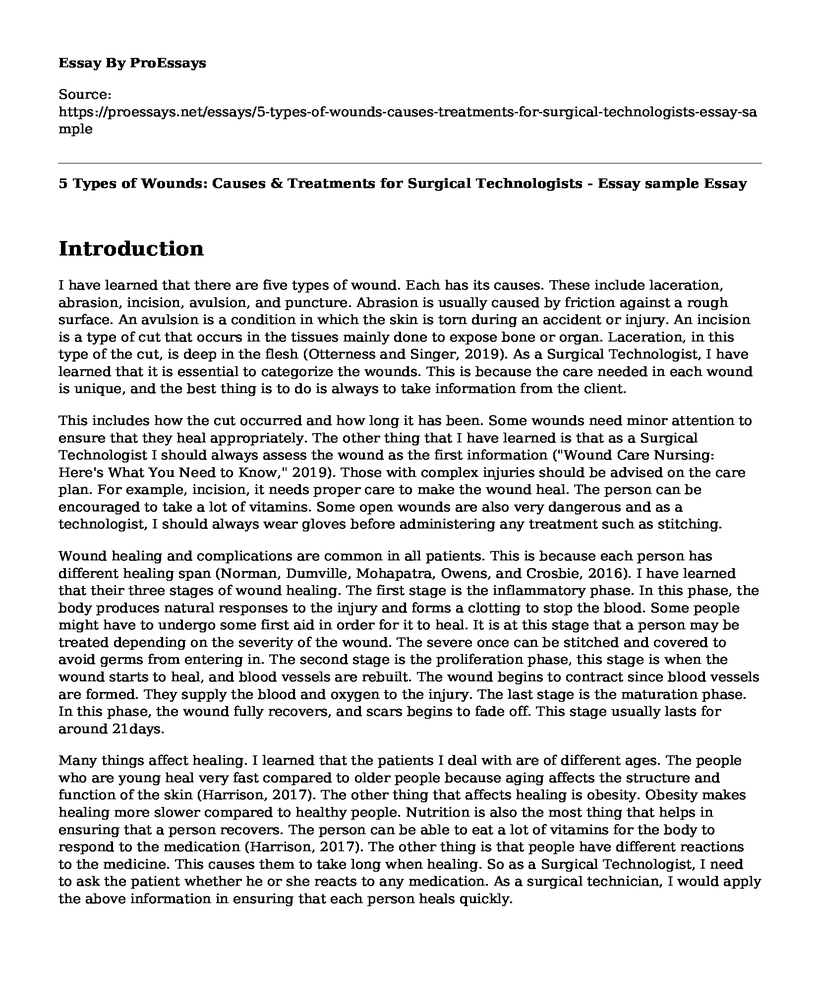Introduction
I have learned that there are five types of wound. Each has its causes. These include laceration, abrasion, incision, avulsion, and puncture. Abrasion is usually caused by friction against a rough surface. An avulsion is a condition in which the skin is torn during an accident or injury. An incision is a type of cut that occurs in the tissues mainly done to expose bone or organ. Laceration, in this type of the cut, is deep in the flesh (Otterness and Singer, 2019). As a Surgical Technologist, I have learned that it is essential to categorize the wounds. This is because the care needed in each wound is unique, and the best thing is to do is always to take information from the client.
This includes how the cut occurred and how long it has been. Some wounds need minor attention to ensure that they heal appropriately. The other thing that I have learned is that as a Surgical Technologist I should always assess the wound as the first information ("Wound Care Nursing: Here's What You Need to Know," 2019). Those with complex injuries should be advised on the care plan. For example, incision, it needs proper care to make the wound heal. The person can be encouraged to take a lot of vitamins. Some open wounds are also very dangerous and as a technologist, I should always wear gloves before administering any treatment such as stitching.
Wound healing and complications are common in all patients. This is because each person has different healing span (Norman, Dumville, Mohapatra, Owens, and Crosbie, 2016). I have learned that their three stages of wound healing. The first stage is the inflammatory phase. In this phase, the body produces natural responses to the injury and forms a clotting to stop the blood. Some people might have to undergo some first aid in order for it to heal. It is at this stage that a person may be treated depending on the severity of the wound. The severe once can be stitched and covered to avoid germs from entering in. The second stage is the proliferation phase, this stage is when the wound starts to heal, and blood vessels are rebuilt. The wound begins to contract since blood vessels are formed. They supply the blood and oxygen to the injury. The last stage is the maturation phase. In this phase, the wound fully recovers, and scars begins to fade off. This stage usually lasts for around 21days.
Many things affect healing. I learned that the patients I deal with are of different ages. The people who are young heal very fast compared to older people because aging affects the structure and function of the skin (Harrison, 2017). The other thing that affects healing is obesity. Obesity makes healing more slower compared to healthy people. Nutrition is also the most thing that helps in ensuring that a person recovers. The person can be able to eat a lot of vitamins for the body to respond to the medication (Harrison, 2017). The other thing is that people have different reactions to the medicine. This causes them to take long when healing. So as a Surgical Technologist, I need to ask the patient whether he or she reacts to any medication. As a surgical technician, I would apply the above information in ensuring that each person heals quickly.
Conclusion
In conclusion, being a Surgical Technologist requires a lot of skill in handling patient wounds. Knowledge of the type of wounds helps, especially in emergency situations. Another finding is that there are necessary measures required when treating wounds from patients of different age as they have different healing patterns. Another factor that I feel should get more focus is how a patient's Lifestyle affects healing patters. Surgical Technologists should understand how to deal with patients who have lifestyle conditions as it may affect how fast they heal. As a Surgical Technologist, I believe that applying some of the industry's practices assures that the patient will be in safe hands.
References
Harrison, M. (2017). Wound healing. Oxford Medicine Online. doi:10.1093/med/9780198765875.003.0057
Norman, G., Dumville, J. C., Mohapatra, D. P., Owens, G. L., & Crosbie, E. J. (2016). Antibiotics and antiseptics for surgical wounds healing by secondary intention. Cochrane Database of Systematic Reviews. doi:10.1002/14651858.cd011712.pub2
Otterness, K., & Singer, A. J. (2019). Updates in emergency department laceration management. Clinical and Experimental Emergency Medicine,6(2), 97-105. doi:10.15441/ceem.18.018
Wound Care Nursing: Here's What You Need to Know. (2019). Retrieved 4 August 2019, from https://www.ameritech.edu/blog/what-to-know-about-wound-care-nursing/
Cite this page
5 Types of Wounds: Causes & Treatments for Surgical Technologists - Essay sample. (2023, Jan 30). Retrieved from https://proessays.net/essays/5-types-of-wounds-causes-treatments-for-surgical-technologists-essay-sample
If you are the original author of this essay and no longer wish to have it published on the ProEssays website, please click below to request its removal:
- The Population, Health Behavior, and the Root Cause of the Behavior
- Steroids: Who's to Blame? Essay
- The Ronald McDonald Charity House - Paper Example
- Research Paper on Nursing in Rural/Remote Canada: Variability, Complexity & Need for Knowledge/Skills
- Essay Sample on Quitting Smoking: Admitting the Addiction and Crafting a Plan
- Paper Example on Health Benefits of Walking for Older Adults: A Limited-Bias Study
- Comprehensive Elderly Assessment: Essential for Health Risks - Free Paper Example







